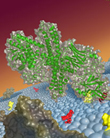 |
Chu Speaks on LRDP
At Noon Today
What will Berkeley Lab look like in 2025? To find out, come to today’s brown bag lunch at noon in the Building 50 auditorium, where Director Steve Chu will moderate a discussion on Berkeley Lab’s 2006 Long Range Development Plan (LRDP). The plan, which will be issued for public comment on Jan. 22, establishes a framework of land-use principles and policies to guide future growth and change at Berkeley Lab through 2025. In addition to Chu, Lab staff instrumental in developing the LRDP will be on hand to answer questions about the comprehensive planning document. Attendees are encouraged to bring their lunch. Cookies and juice will be provided. Offsite employees can view a live broadcast here. Go here for more information on the LRDP.
Governor Repeats Call
For Science, Innovation
In his State-of-the-State address on Tuesday, Governor Schwarzenegger reiterated his pledge made in December to seek funding for a Strategic Research and Innovation Initiative, which will provide $95 million to major projects in three key sectors: "clean" technology, biotechnology and nanotechnology. Among the beneficiaries would be Berkeley Lab, with a stake in three projects -- Helios, BP's Energy Biosciences Institute, and the petascale supercomputer. Go here to read specifics of the State's innovation proposal, and here to watch a video of Lab Director Steve Chu recorded after the Governor's announcement in December (Note: KTVU Channel 2 did not mention Berkeley Lab but, rather, chose to identify Chu as a UC Berkeley physicist, even though the footage was shot at the Lab).
 |
 |
|
 |
Affirmative Action
And EEO Policy
The Laboratory will not engage in discriminatory practices against any person employed or seeking employment because of race, color, religion, marital status, national origin, ancestry, sex, sexual orientation, gender identity, pregnancy (including pregnancy childbirth, and medical conditions related to pregnancy or childbirth), physical or mental disability, medical condition (cancer related or genetic characteristics), age, citizenship, or status as a covered veteran, special disabled veteran, Vietnam-era veteran, veteran who served on active duty during a war or in a campaign or expedition for which a campaign badge has been authorized, or any veteran during the one-year period that begins on the date of such veteran's discharge or release from active duty.
This applies to all personnel actions, including hiring, transfer, training, promotion, termination, and other terms and conditions of employment. The Laboratory's policy is to take affirmative action, through formally written affirmative action plans, for minorities, women, individuals with disabilities, special disabled veterans, Vietnam-era veterans, and any other veteran who served on active duty during a war or in a campaign or expedition for which a campaign badge has been authorized. Go here to read the entire policy.
 |
 |
|
 |
|
 |
A Potential New Way
For Stopping Tumors
The active ingredient in a drug currently being tested to treat rheumatoid arthritis might also one day serve as an effective means of treating one of the deadliest forms of breast cancer. Berkeley Lab life scientists Mina Bissell and Paraic Kenny have demonstrated that inhibiting the activity of the protease enzyme known as TACE can deprive tumor cells of a key factor needed for their proliferation. TACE is strongly present in a form of breast cancer that responds poorly to current therapies. Full story.
Study Could Improve Treatment of Botulism
|
|
|
|
 |
 |
|
|
| Botulinum |
|
|
|
Of all the weapons in the bioterrorist arsenal, none is as potent as botulinum neurotoxin, which causes botulism — a potentially fatal disease with symptoms that include severe paralysis of the limbs and respiratory muscles. Just 1 gram of botulinum neurotoxin, evenly dispersed and inhaled, could kill more than a million people, according to a 2001 study in the Journal of the American Medical Association. Now, for the first time, scientists from Stanford University and the Medical School of Hannover in Germany have figured out how this powerful neurotoxin binds to and disables individual nerve cells. The X-ray crystallography for this research was conducted in part at Berkeley Lab's Advanced Light Source. Full story.
 |
 |
|
 |
MLK Holiday
On Monday
The Lab will be closed on Monday in recognition of the Martin Luther King, Jr. holiday. The facility will re-open on Tuesday, Jan. 16.
Cold Weather Signals
Warning to Be Prepared
California emergency and health officials have urged preparedness in response to extremely cold temperatures that are expected to blanket the state over the new few days. Dr. Mark Horton, State Public Health Officer, says, “To protect yourself in extremely cold weather, remember to wear several layers of clothing, travel with caution and be alert for the symptoms of exposure. Monitor family members and those around you who are at greatest risk from exposure, such as seniors, young children and people with underlying illnesses or chronic conditions.” A list of actions to be taken can be read here. |
 |
|

